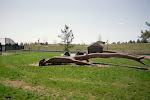Last week I took a cataloging sound recordings class. I never knew that there would be another group in the library world like serialists...who are thrown into just as many odd situations and subjected to the quirks of publishers as we are.
Apparently, most of the cataloging for sound recordings is done from the piece in hand and not just copy cataloged. The information that is mandatory for each piece is sometimes not available since the cataloger is supposed to rely on the item itself (i.e. the cassette, CD, etc) and then go to the container and lastly resort to any printed material that accompanies it. We did examples of several different types of sound recordings and you would think that the industry would display the "standard" items like title, series and such on each piece or container. But, like serials, we had a merry chase determing these things on some of the items in question.
As if that was not enough to drive any sane person to distraction, the sound cataloger has to decide if it is a collection of works, if the sound recording is dominated by a principal peformer or the work of one person or a corporate body. There is a decision tree for this, but 2 catalogers looking at the same piece might, justifiably, arrive at different conclusions.
It would seem that the largest print might be the title, right? Wrong. Apparently the largest or most prominent typeface may just be a performer or narrator and not actually the title itself.
Then we come to dates. Now, here is where things parallel serials quite well. In serials there is publication date and cover chronology. Publishers do not feel compelled to make sure these match. In sound recordings they have something similar -- there might be an original recording date and a release date. And to throw one more twist in, if the item is a spoken version of a book or play, there is also the date of the publication for the print item. And it is often left up to the mercy of the cataloger to figure out which is what. Again, there is the emphasis on using the piece in hand as your primary source of information. If there are dates with no notes next to them it can be tricky to figure out which date goes to the recording, the book/play and the release date.
As for mediums, the sound cataloger has more types to be potentially tortured by than serialists do. There is something called a playaway, which is a self-contained sound recording. They also have to deal with items on the internet, as well as 8 tracks, cassettes, something called dual discs, mini cds, dvd audios, cd-roms, midi files, mp3 files and shaped discs. Unlike serials, though, they might have to catalog each piece separately, even if it is in a series. The poor cataloger working with each of these items also has to describe the physical item as well, sometimes in a note when measurements do not make things clearer.
Oh, and did I mention that if it is a musical sound recording there are different rules for if the piece is an artist's interpretation of the work, like popular music, rock and jazz or if the performer is merely executing the work, like classical music? Or that if it is a book with a readalong sound component...it is up to the cataloger which is primary -- the book or the audio....And on it goes...!
I think there should be a retreat for befuddled serialists or sound catalogers. Those who strive valiantly in the cause of making items accessible to patrons, but who are inevitably driven to distraction or even insanity due to the publishers and distributors who endeavor to make themselves and their works as clear as mud as often as possible...!
6.23.2009
Serials sisters/brothers in arms...
Labels:
dates,
items,
music,
publication date,
release date,
serials,
series,
sound cataloging
Subscribe to:
Post Comments (Atom)




No comments:
Post a Comment